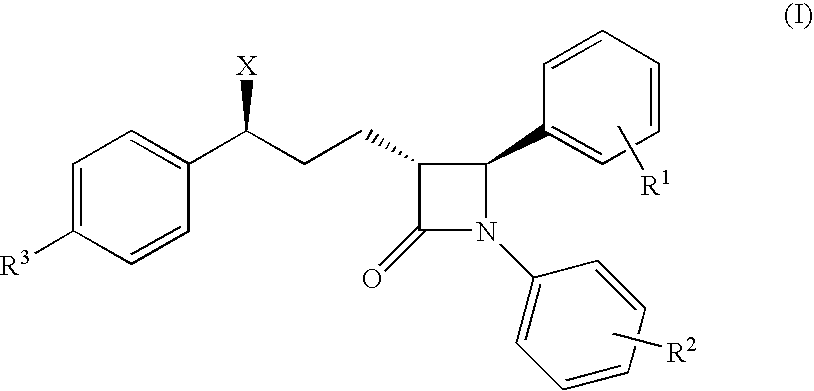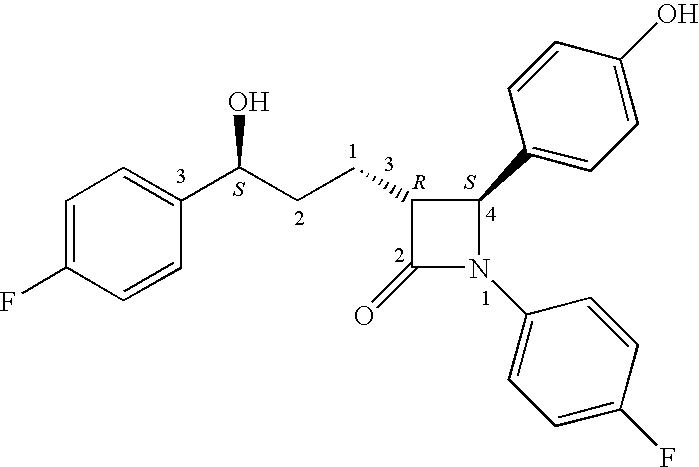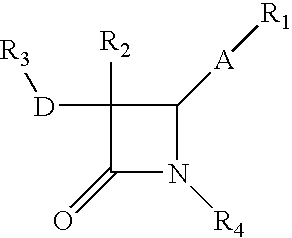Process for the preparation of diphenyl azetidinone derivatives
a technology of diphenyl azetidinone and diphenyl azetidinone, which is applied in the field of preparation of cholesterol-lowering agents and pharmaceutical compositions, can solve the problems of large amounts of silylating agents and additional separation stages, and achieve the effect of maintaining the reduction of cholesterol levels and treating high blood serum cholesterol levels
- Summary
- Abstract
- Description
- Claims
- Application Information
AI Technical Summary
Benefits of technology
Problems solved by technology
Method used
Image
Examples
example 1
Methyl 5-(4-fluorophenyl)-5(S)-hydroxypentanoate By Asymmetric (R)-Me-CBS—Catalyzed Keto Reduction
[0078]
[0079]890 ml of dichloromethane are introduced under nitrogen into a four-neck round-bottom flask with mechanical stirrer, dropping funnel with micrometering and thermosensor. 210 ml (420 mmol) of a 2 M solution of borane-dimethyl sulfide complex in THF are added, and the solution is then cooled to −5° C. 21 ml (21.4 mmol) of a 1.02 M solution of (R)-tetrahydro-1-methyl-3,3-diphenyl-1H,3H)-pyrrolo[1,2-C][1,3,2]oxazaborolidine in toluene [“(R)-Me CBS”, supplied by Strem] are added, and the reaction mixture is stirred at −5° C. for 15 min. A solution of 93.5 g (414.5 mmol) of 99.4% pure methyl 5-(4-fluorophenyl)-5-oxo-pentanoate in 600 ml of dichloromethane is added dropwise at a uniform rate over the course of 3 h at −5° C., followed by stirring for 1 h. A check by thin-layer chromatography (=TLC) (ethyl acetate / n-heptane 8:2) shows complete conversion of the keto ester to the hydr...
example 2
Methyl 5(S)-(tert-butyldimethylsilanyloxy)-5-(4-fluorophenyl)pentanoate
[0081]
[0082]A solution of 90.5 g (368 mmol) of the 92% pure hydroxy ester from Example 1 in 800 ml of dichloromethane is introduced into a 2-neck round-bottom flask with mechanical stirrer, dropping funnel and thermosensor under nitrogen. 54.5 g (800 mmol) of imidazole are added and dissolved after brief stirring, during which the internal temperature falls from 20° C. to 13° C. A solution of 74.5 g (479 mmol) of 97% pure tert-butyldimethyl-chlorosilane in 135 ml of dichloromethane is added dropwise, during which the internal temperature rises from 14° C. to 27° C. and a white precipitate separates out. The reaction mixture is then boiled under reflux for 4 h. A TLC check (ethyl acetate / n-heptane 1:1) now shows only a trace of precursor. The suspension is filtered through 200 g of silica gel 60 (Merck, 0.035-0.07 mm) which have been packed into a column as slurry in 500 ml of dichloromethane. Washing (elution) is...
example 3
[2(S)-Hydroxy-1(S)-methyl-2-phenylethyl]-N-methyl-5(S)-(tert-butyldimethyl-silanyloxy)-5-(4-fluorophenyl)pentanamide
[0083]
[0084]A solution of 5.03 g (117 mmol) of anhydrous 99% pure lithium chloride and 9.9 g (58.7 mmol) of 98% pure (+)-(1S,2S)-pseudoephedrine in 81 ml of absolute THF in a thoroughly heat-dried three-neck round-bottom flask with magnetic stirrer, septum and thermometer is cooled to <2° C. in an ice bath. 5.9 ml (14.6 mmol) of a 2.5 molar solution of n-butyllithium in hexane are added dropwise by syringe through the septum over the course of 10 min, during which the internal temperature of the clear reaction solution rises to 5° C. After 10 min, a solution of 25 g (53.6 mmol) of the 73% pure ester from Example 2 in 17 ml of absolute THF is added dropwise over the course of 30 min. The reaction mixture is then stirred at room temperature for 36 h. A TLC check (ethyl acetate / n-heptane 1:1) shows the precursor and the product in the ratio of about 1:3. 80 ml of water ar...
PUM
| Property | Measurement | Unit |
|---|---|---|
| boiling point | aaaaa | aaaaa |
| temperature | aaaaa | aaaaa |
| temperature | aaaaa | aaaaa |
Abstract
Description
Claims
Application Information
 Login to View More
Login to View More - R&D
- Intellectual Property
- Life Sciences
- Materials
- Tech Scout
- Unparalleled Data Quality
- Higher Quality Content
- 60% Fewer Hallucinations
Browse by: Latest US Patents, China's latest patents, Technical Efficacy Thesaurus, Application Domain, Technology Topic, Popular Technical Reports.
© 2025 PatSnap. All rights reserved.Legal|Privacy policy|Modern Slavery Act Transparency Statement|Sitemap|About US| Contact US: help@patsnap.com



